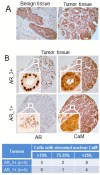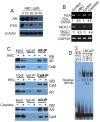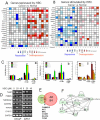Hydrazinobenzoylcurcumin inhibits androgen receptor activity and growth of castration-resistant prostate cancer in mice
- PMID: 25704883
- PMCID: PMC4467427
- DOI: 10.18632/oncotarget.3346
Hydrazinobenzoylcurcumin inhibits androgen receptor activity and growth of castration-resistant prostate cancer in mice
Abstract
There is a critical need for therapeutic agents that can target the amino-terminal domain (NTD) of androgen receptor (AR) for the treatment of castration-resistant prostate cancer (CRPC). Calmodulin (CaM) binds to the AR NTD and regulates AR activity. We discovered that Hydrazinobenzoylcurcumin (HBC), which binds exclusively to CaM, inhibited AR activity. HBC abrogated AR interaction with CaM, suppressed phosphorylation of AR Serine81, and blocked the binding of AR to androgen-response elements. RNA-Seq analysis identified 57 androgen-regulated genes whose expression was significantly (p ≤ 0.002) altered in HBC treated cells as compared to controls. Oncomine analysis revealed that genes repressed by HBC are those that are usually overexpressed in prostate cancer (PCa) and genes stimulated by HBC are those that are often down-regulated in PCa, suggesting a reversing effect of HBC on androgen-regulated gene expression associated with PCa. Ingenuity Pathway Analysis revealed a role of HBC affected genes in cellular functions associated with proliferation and survival. HBC was readily absorbed into the systemic circulation and inhibited the growth of xenografted CRPC tumors in nude mice. These observations demonstrate that HBC inhibits AR activity by targeting the AR NTD and suggest potential usefulness of HBC for effective treatment of CRPC.
Keywords: CTK7A; androgen receptor; calmodulin; castration-resistant prostate cancer; hydrazinobenzoylcurcumin.
Figures






Similar articles
-
Androgen receptor (AR) degradation enhancer ASC-J9® in an FDA-approved formulated solution suppresses castration resistant prostate cancer cell growth.Cancer Lett. 2018 Mar 28;417:182-191. doi: 10.1016/j.canlet.2017.11.038. Epub 2018 Jan 17. Cancer Lett. 2018. PMID: 29203251
-
Combination of carmustine and selenite effectively inhibits tumor growth by targeting androgen receptor, androgen receptor-variants, and Akt in preclinical models: New hope for patients with castration resistant prostate cancer.Int J Cancer. 2016 Oct 1;139(7):1632-47. doi: 10.1002/ijc.30189. Epub 2016 Jun 10. Int J Cancer. 2016. PMID: 27198552
-
Androgen receptors in hormone-dependent and castration-resistant prostate cancer.Pharmacol Ther. 2013 Dec;140(3):223-38. doi: 10.1016/j.pharmthera.2013.07.003. Epub 2013 Jul 13. Pharmacol Ther. 2013. PMID: 23859952 Review.
-
NDRG2 acts as a negative regulator downstream of androgen receptor and inhibits the growth of androgen-dependent and castration-resistant prostate cancer.Cancer Biol Ther. 2015;16(2):287-96. doi: 10.1080/15384047.2014.1002348. Cancer Biol Ther. 2015. PMID: 25756511 Free PMC article.
-
Androgen receptor: what we know and what we expect in castration-resistant prostate cancer.Int Urol Nephrol. 2018 Oct;50(10):1753-1764. doi: 10.1007/s11255-018-1964-0. Epub 2018 Aug 20. Int Urol Nephrol. 2018. PMID: 30128923 Review.
Cited by
-
N-terminal domain of androgen receptor is a major therapeutic barrier and potential pharmacological target for treating castration resistant prostate cancer: a comprehensive review.Front Pharmacol. 2024 Sep 18;15:1451957. doi: 10.3389/fphar.2024.1451957. eCollection 2024. Front Pharmacol. 2024. PMID: 39359255 Free PMC article. Review.
-
Castration-resistant prostate cancer: Androgen receptor inactivation induces telomere DNA damage, and damage response inhibition leads to cell death.PLoS One. 2019 May 13;14(5):e0211090. doi: 10.1371/journal.pone.0211090. eCollection 2019. PLoS One. 2019. PMID: 31083651 Free PMC article.
-
Epigenetic modulators as therapeutic targets in prostate cancer.Clin Epigenetics. 2016 Sep 15;8:98. doi: 10.1186/s13148-016-0264-8. eCollection 2016. Clin Epigenetics. 2016. PMID: 27651838 Free PMC article. Review.
-
Androgen receptor CAG and GGN repeat length variation contributes more to the tumorigenesis of osteosarcoma.Oncotarget. 2016 Oct 18;7(42):68151-68155. doi: 10.18632/oncotarget.11902. Oncotarget. 2016. Retraction in: Oncotarget. 2017 May 16;8(20):34019. doi: 10.18632/oncotarget.17877. PMID: 27626686 Free PMC article. Retracted.
-
KAT's in the Cradle: p300/CBP and Regulation of HIF-1 and Blood Pressure during Intermittent Hypoxia.Am J Respir Cell Mol Biol. 2024 Feb;70(2):87-88. doi: 10.1165/rcmb.2023-0435ED. Am J Respir Cell Mol Biol. 2024. PMID: 38109691 Free PMC article. No abstract available.
References
-
- Siegel R, Naishadham D, Jemal A. Cancer statistics, 2013. CA Cancer J Clin. 2013;63(1):11–30. - PubMed
-
- Feldman BJ, Feldman D. The development of androgen-independent prostate cancer. Nat Rev Cancer. 2001;1(1):34–45. - PubMed
-
- Bastos DA, Dzik C, Rathkopf D, Scher HI. Expanding androgen- and androgen receptor signaling-directed therapies for castration-resistant prostate cancer. Oncology (Williston Park, NY) 2014;28(8):693–699. - PubMed
Publication types
MeSH terms
Substances
Grants and funding
LinkOut - more resources
Full Text Sources
Other Literature Sources
Research Materials

